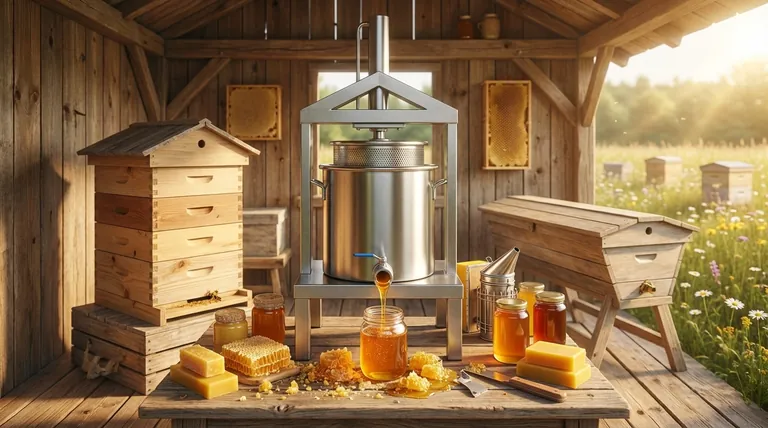At its core, a honey press is the ideal extraction tool for Warré and Top Bar hives because these beekeeping methods do not require the reuse of comb. Unlike Langstroth hives where preserving drawn-out comb is critical for hive productivity, Warré and Top Bar harvests involve removing and crushing the comb, a process for which a press is perfectly designed.
For beekeepers using foundationless hives, the choice is not merely about convenience; it's about aligning your equipment with your beekeeping philosophy. A honey press perfectly matches the "crush and strain" harvest method inherent to Warré and Top Bar systems.

Why a Press Aligns with Natural Beekeeping
The primary benefit of a honey press stems from its compatibility with the core principles of foundationless beekeeping, as practiced in Warré and Top Bar hives.
The "Crush and Strain" Philosophy
In these systems, bees build their own comb from scratch each season. This comb is harvested along with the honey and is not returned to the hive.
A honey press is built for exactly this workflow. You simply crush the comb and use the press to efficiently squeeze out every last drop of honey, separating it from the wax.
Maximizing Your Harvest Yield
A press applies steady, powerful pressure to the crushed comb, ensuring minimal honey is left behind in the wax.
This method is highly effective and can be more efficient than letting crushed comb drip-strain on its own, reducing overall honey wastage from your harvest.
Preserving Honey's Natural Qualities
Many beekeepers find that pressing honey, as opposed to high-speed centrifugal extraction, is a gentler process.
This method preserves the honey's natural character and allows the beekeeper to produce honey with varying amounts of comb or wax, catering to different consumer preferences.
Practical Advantages for the Small-Scale Beekeeper
Beyond philosophical alignment, honey presses offer tangible benefits that make them particularly well-suited for hobbyists and smaller operations.
Affordability and Versatility
Honey presses are often more reasonably priced than centrifugal extractors of similar capacity. Their simple, robust design also makes them incredibly versatile—many can be used as a fruit press for making cider or wine.
Portability and Small Footprint
Compared to bulky extractors, honey presses are typically lightweight and have a much smaller footprint.
They are easy to move, can be disassembled for compact storage, and are convenient to transport, making them perfect for beekeepers with limited space or those who share equipment.
Understanding the Trade-offs
To make an informed decision, it's critical to understand the limitations and demands of using a honey press.
The Labor-Intensive Process
There is no "easy button." Using a honey press is a manual, labor-intensive process that can be time-consuming.
Crushing the comb, loading the press, turning the crank, and cleaning up afterward requires significant physical effort compared to a motorized extractor.
The Comb Is Not Reusable
This is a feature for Warré and Top Bar beekeepers, but it is a critical drawback for other hive types. The process completely destroys the comb.
While you gain a secondary harvest of clean beeswax after rendering, you lose the energy resource the bees invested in creating that comb in the first place.
Making the Right Choice for Your Hive
A honey press isn't just a tool; it's a choice that reflects your beekeeping goals.
- If your primary focus is natural beekeeping with Warré or Top Bar hives: A honey press is the most philosophically and practically aligned tool for your harvest.
- If your primary focus is a small-scale, budget-conscious operation: The affordability, compact size, and efficiency of a press make it an excellent investment.
- If your primary focus is maximizing speed and minimizing physical labor for large harvests: You should be aware that a press is a manual process and a centrifugal extractor may better suit your needs.
Ultimately, choosing a honey press empowers you to conduct a harvest that is fully in sync with the natural cycle of your foundationless beehive.
Summary Table:
| Benefit | Description |
|---|---|
| Philosophical Alignment | Perfectly suited for the "crush and strain" method of foundationless hives like Warré and Top Bar. |
| Maximizes Yield | Steady, powerful pressure extracts more honey from the crushed comb compared to drip-straining. |
| Preserves Honey Quality | A gentler process than centrifugal extraction, maintaining the honey's natural character. |
| Cost-Effective & Versatile | Often more affordable than extractors and can double as a fruit press for cider or wine. |
| Compact & Portable | Lightweight with a small footprint, ideal for beekeepers with limited space. |
Ready to harvest in harmony with your natural beekeeping practice?
At HONESTBEE, we supply high-quality beekeeping supplies and equipment to commercial apiaries and distributors. Our honey presses are built for durability and efficiency, helping you maximize your yield from Warré and Top Bar hives.
Contact our wholesale experts today to find the perfect honey press for your operation and learn about our full range of equipment tailored for serious beekeepers.
Visual Guide

Related Products
- Electric Honey Press Machine for Squeezing Honey Comb Press Equipment
- 10L Stainless Steel Electric Honey Press Machine
- Easy Use Manual Stainless Steel Honey Press for Honey Comb
- Stainless Steel Honey Press Wax Press with Tank
- Stainless Steel Manual Honey Press with Guard for Pressing Honey and Wax
People Also Ask
- How was the honey press cleaned after use? Quick vs. Deep Cleaning Methods Explained
- How can the honey press be cleaned after use? A Step-by-Step Guide for Commercial Beekeepers
- How can a honey press be used beyond honey extraction? Unlock Its Full Potential for Your Farm
- What are the reasons for choosing a honey press over a dedicated honey extractor? Maximize Disease Control and Natural Beekeeping
- How should a honey press be cleaned? A Step-by-Step Guide for Beekeepers



















